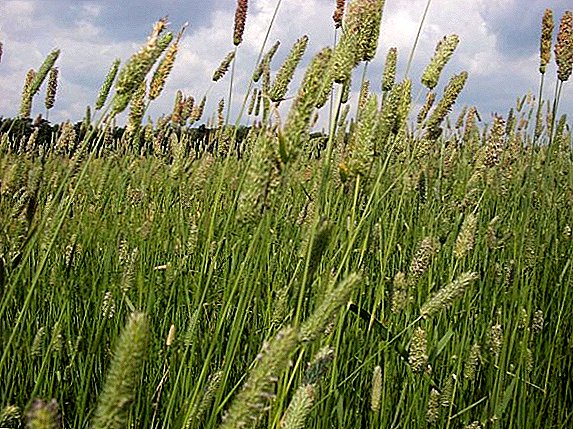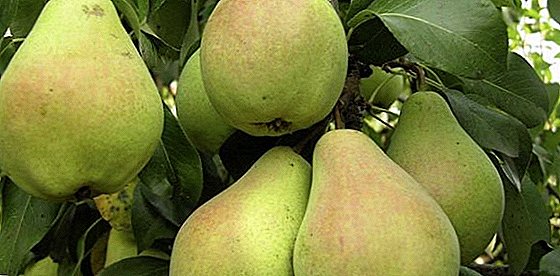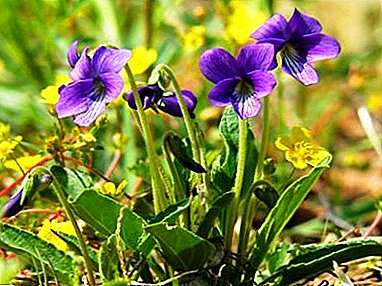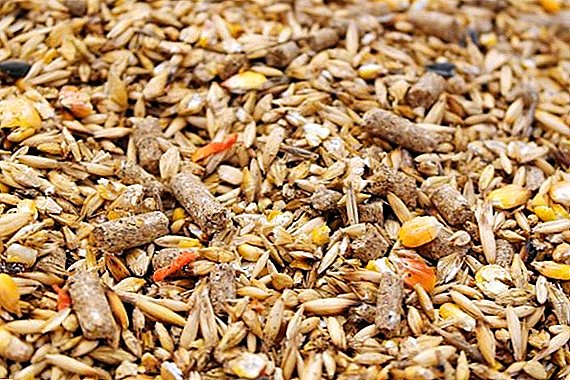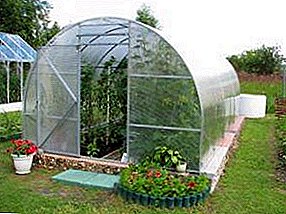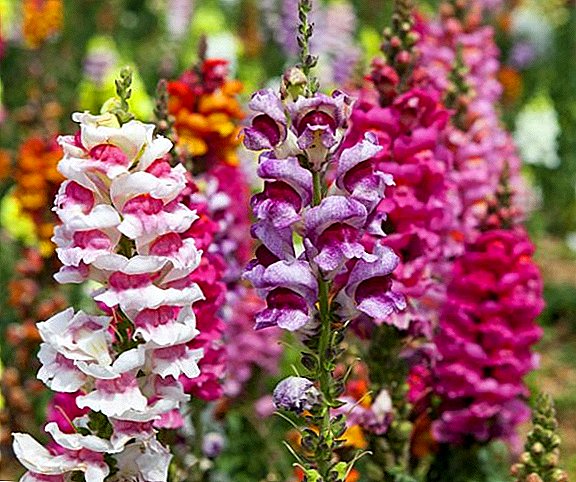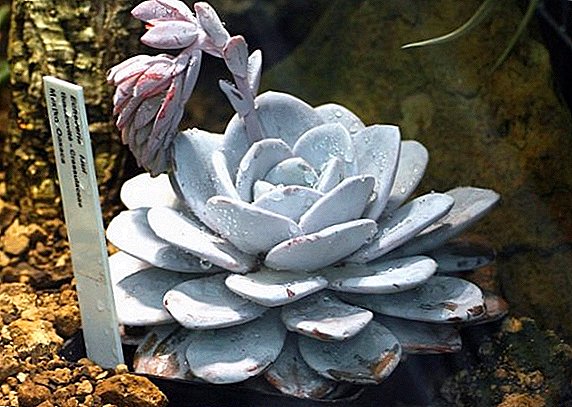 Echeveria is a herbaceous perennial of the family Crassulaceae, popularly called the "stone flower". The unusual appearance made the flower popular in the design of gardens and mini-parks, and a variety of species allows you to create original compositions.
Echeveria is a herbaceous perennial of the family Crassulaceae, popularly called the "stone flower". The unusual appearance made the flower popular in the design of gardens and mini-parks, and a variety of species allows you to create original compositions.
Agavoid (Echeveria agavoides)
This species grows like a bush, the stem, as a rule, is absent or short. The socket consists of a dense, fleshy leaves of a triangular-oval shape with a pointed tip and a wax coating.
Length up to 9 cm, width about 6 cm. Color is light green with a red border on a translucent edge. At the end of May, long, up to 40 cm, orange-red pedicels sprout from the base of the rosette; these elongated bells are crowned with bells with five sharp petals.
It will be useful for you to learn how to properly care for echeveria at home.
From the outside, they are painted in a reddish tone, closer to the sharp tips - green, the inside of the petals is bright yellow with yellow-green anthers. An interesting sort of "Lipstick" with a large rosette of 20 leaves.
If the bush is under the sun, the leaves turn pink.
Did you know? The plant got its name in honor of the illustrator Anastasio Echeverría, who supplemented the book on the flora of Mexico with his drawings.
White-haired (Echeveria leucotricha)
Semishrub, sockets grow on a sturdy brownish stem. Dense leaves up to 15 cm in length are pubescent with a thick, long pile, because of which they appear bluish.
The tips are red. During the flowering period, from March to May inclusive, flowers appear on light green, thick and long, up to 40 cm, peduncles - five-petal, elongated bells of bright orange, sometimes red color.
Brilliant (Echeveria fulgens)
Brilliant echeveria - unbranched shrub with short but thick stems. The shape of the bush is rounded. Leaf blades up to 10 cm long, 4 cm wide. The shape is elongated, oval, wavy edges with small grooves, gray-green.
The flowering period occurs in winter, affecting the beginning of spring. Peduncles many-flowered, red tint. Bells are red-orange from the outside, yellow-orange from the inside.
The most famous variety is "Flying Cloud" with broad rounded leaves, forming a rosette in the form of a cabbage.
Important! Plants are fed only once a year. - spring-summer. Excess fertilizer leads to a loss of healthy appearance and decoration.
Brokeback (Echeveria gibbiflora)
Crochet echeveria - bush with tree stems, on the end of which rosettes of 15-20 leaves are formed. They are large, up to 25 cm in length and 15 cm in width. Form - wide, irregular oval, sheet plate curved, wavy.
The shade is bluish-green, with a slight red border around the edge. On the upper side of the leaf plates are often the growths of irregular shape. The plant blooms at the end of summer and blooms before winter. The inflorescence on a long pedicel is of a red tone, in the shape of a ball, formed by a multitude of red bells on the outside and yellow inside.
Popular varieties in gardening:
- "Carunculata" - leaf plates covered with tubercles, slightly twisted;

- "Metallica" - the socket is red-green or with a bronze tint, fringed with a white or red stripe;

- "Crispata" - leaves wavy along the edge, with a metallic sheen.
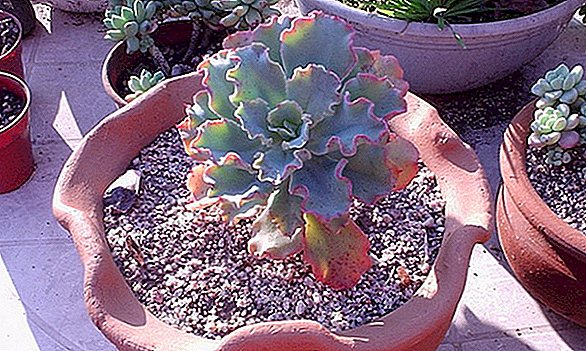
Familiarize yourself with other species of plants included in the group of succulent plants, such as hatiora, kalanchoe, aloe, havortia, aihrizon, agave, and fatty grass.
Derenberg (Echeveria derenbergii)
Echeveria Derenberg - dense shrub, formed by a set of leaves on long stems. The stems are creeping, the foliage is dense, leathery, light-green with white bloom, along the edge is a red stripe, the tip of the leaf is pointed, resembles a thorn. The length of the sheet plate is 4 cm, width 2.5 cm.
Flowering time - from April to June. Peduncles branched, short, up to 6 cm, many-flowered. The flowers are orange-yellow bells, the form of petals is wide with a sharp tip.
Graceful (Echeveria elegans Rose)
The rosette of the Echeveria, with its elegant appearance, resembles a blooming rose flower. Sessile close to each other leaves - light green in the form of wide petals with a sharp spike at the end. Flowering period - from May to June.
Thin light peduncle crowned 4-5 red-yellow bells.
Sort "Blue" differs bluish bloom on all parts of the bush.
Did you know? All kinds of plants - succulents. Cultures of this type in dense, fleshy parts accumulate moisture, which helps them to survive in places with arid climate where they come from. Succulents have one peculiarity: during the period of severe drought, all the aboveground parts die off, and when moisture appears, they are immediately restored.
Lau (Echeveria laui)
A large rosette of stone roses of the Echeveria laui variety in diameter is more than 20 cm. The fleshy leaves are in the shape of a rounded triangle of almost white color due to the thick wax coating on them. Width is up to 3 cm, length is up to 6 cm.
The plants are covered with wax and the inflorescences are large, up to 2 cm, the bells are bright yellow on the inside. The bush blossoms in February-April.
Peakotsky (Echeveria peacockii)
Sessile, wide, dense, in the form of a blade the leaves form a bush 15 cm in diameter. They have a gray scurf, have a red stripe along the edge and a sharp tip on the top of the plate. Length 5 cm, width 3 cm. From April to June blooms in red flowers, with white bloom on the outside of the flower.
The top of long thin peduncles drooping, stem of a red shade.
You may be interested to read about how you can make a mini-garden in the glass.
Pillow (Echeveria pulvinata)
Echeveria cushion - It is a small bush with elongated oval, densely pubescent, pale green leaves. The sheet plate is concave the top side of the sheet. It is very dense, up to 1 cm thick, 5 cm long, 3 cm wide. A loose bush grows up to 20 cm tall.
In March-April, a straight stalk of a peduncle shoots, also in the fringe, light green. The flowers are yellow with red.
The following varieties are known:
- "Frosty" - sheet plates elongated triangular, pale green, almost white with whitish pile;
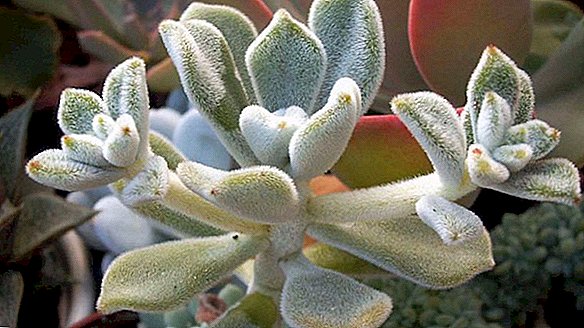
- "Ruby Blush" - more juicy green rosette, gloss is visible under the nap.
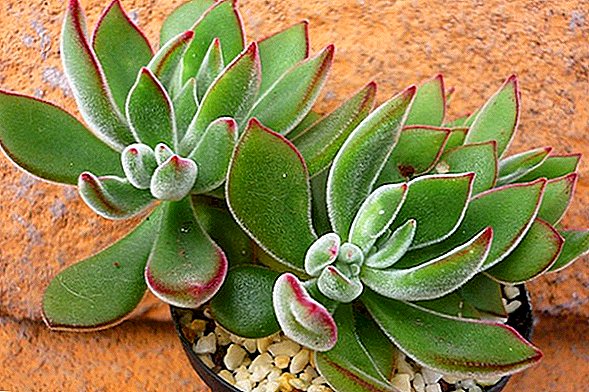
Sho (Echeveria shaviana)
On a short stalk large flat leafy plates of green color with a gray bloom are located.
The top of them is wavy-cut, on the tip - a sharp spike. The flowering period begins in June, the flowers are yellow-pink, the peduncles are straight, branched.
Popular varieties:
- "Grassa" - leaves with a bluish tint, the top edge is bent toward the center of the outlet;
- "Pink Frills" - it is distinguished by a slightly wavy edge of petals and a pink sheen;

- "Pinky" - also pours pink, bush more loose, deciduous part of a more elongated shape.
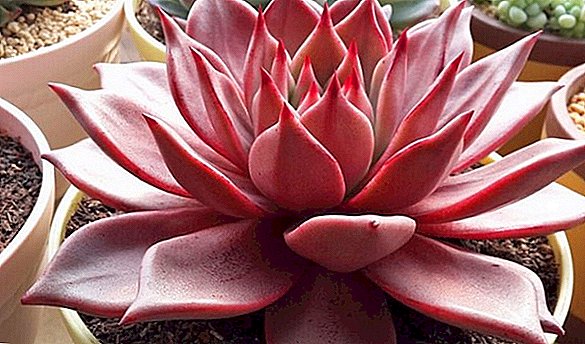
Important! When watering the plants at home using soft, separated, warm water. It is advisable not to fall on the leaves, because, evaporating in the sun, moisture will leave a burn.
Bristle (Echeveria setosa)
Echeveria has a bristly dense bush, practically without a stem. Dense leathery leafy plates of elongated shape, dark green color, covered with whitish bristles.
Peduncle pale green, erect, many-flowered. The petals are red, with a yellow tint at the edges and on the inside.
- "Doris Taylor" - hybrid of echeverias bristly and pillow, large shrub in diameter up to 30 cm, tip of apex red-brown;
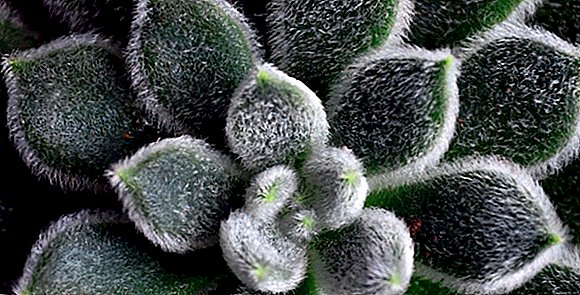
- "Rundeli" - variety with dark red stalks of peduncles and a bluish-green rosette.

Yazyobraznaya (Echeveria linguaefolia Lem)
Echeveria species lingual forms a rosette on two strong stems. The shape of the leaves really resembles the tongue, obovate, with a blunt top and a sharp, slightly pronounced tip. The color is almost white from plaque, which is easy to wipe.
Sometimes it blooms in the middle of winter, but more often - from March to May. Peduncles thick, drooping, bright orange flowers.
Plants are unpretentious in the care, they can be grown at home and in the open field. With the help of different types of Echeveria, landscape designers create unusual and original compositions.











